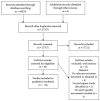Exploring the Role of Wearable Technology in Sport Kinematics and Kinetics: A Systematic Review
- PMID: 30987014
- PMCID: PMC6480145
- DOI: 10.3390/s19071597
Exploring the Role of Wearable Technology in Sport Kinematics and Kinetics: A Systematic Review
Abstract
The aim of this review was to understand the use of wearable technology in sport in order to enhance performance and prevent injury. Understanding sports biomechanics is important for injury prevention and performance enhancement and is traditionally assessed using optical motion capture. However, such approaches are limited by capture volume restricting assessment to a laboratory environment, a factor that can be overcome by wearable technology. A systematic search was carried out across seven databases where wearable technology was employed to assess kinetic and kinematic variables in sport. Articles were excluded if they focused on sensor design and did not measure kinetic or kinematic variables or apply the technology on targeted participants. A total of 33 articles were included for full-text analysis where participants took part in a sport and performed dynamic movements relating to performance monitored by wearable technologies. Inertial measurement units, flex sensors and magnetic field and angular rate sensors were among the devices used in over 15 sports to quantify motion. Wearable technology usage is still in an exploratory phase, but there is potential for this technology to positively influence coaching practice and athletes' technique.
Keywords: athlete; coaching; kinematics; motion analysis; sensors; sports performance; wearables.
Conflict of interest statement
The authors declare no conflict of interest.
Figures
References
-
- Jones R.L., Wallace M. Another bad day at the training ground: Coping with ambiguity in the coaching context. Sport Educ. Soc. 2005;10:119–134. doi: 10.1080/1357332052000308792. - DOI
-
- Pueo B., Jimenez-Olmedo J. Application of motion capture technology for sport performance analysis. Retos. 2017;32:241–247.
-
- Krüger A., Edelmann-Nusser J. Biomechanical analysis in freestyle snowboarding: Application of a full-body inertial measurement system and a bilateral insole measurement system. Sports Technol. 2009;2:17–23. doi: 10.1080/19346182.2009.9648494. - DOI
-
- Bachlin M., Troster G. Swimming performance and technique evaluation with wearable acceleration sensors. Pervasive Mob. Comput. 2012;8:68–81. doi: 10.1016/j.pmcj.2011.05.003. - DOI
Publication types
MeSH terms
LinkOut - more resources
Full Text Sources


